







To the Kansas City community,
For more than 20 years, we have partnered with Union Station to help ensure Kansas City audiences have access to world-class content and experiences.
From helping build Union Station’s Bank of America Gallery to sponsoring multiple exhibitions including Disney100: The Exhibition, we are honored to invest in important projects that bring history and culture to our community.
Speaking of history, we are delighted to share a bit of the Disney story you may not have expected.
Bank of America’s relationship with The Walt Disney Company began with its first line of credit in 1930, marking the beginning of a relationship that has lasted decades and seen the financing of some of Disney’s most iconic projects.
Through our partnership with Union Station, we are pleased to display artifacts from our own heritage and archives that highlight our company’s relationship with The Walt Disney Company.
We helped to finance Disney’s first animated feature-length film, Snow White and the Seven Dwarfs (1937), and many others that followed. We also provided financing for the construction of Disney’s animation studio in Burbank, California, as well as for Disneyland in Anaheim. And we sponsored the 1966 opening of "it's a small world" where we featured the BankAmericard, one of our most iconic products and among the first credit cards to be accepted at Disneyland.
We're proud of our history with Disney and we feel fortunate to have ties back to when Walt Disney was in the early stages of building his company. Indeed, the Bank of America, Disney, and Union Station stories are tightly woven together which makes this presenting sponsorship especially meaningful.
We hope you enjoy Disney100: The Exhibition.
Sincerely,
 Matt Linski President, Bank of America Kansas City
Matt Linski President, Bank of America Kansas City
2 Union Station On Track • Disney100: The Exhibition


ON TRACK
CHIEF MARKETING OFFICER
Michael Tritt
ASSOCIATE VICE PRESIDENT, MARKETING
Lauren Hypse
MARKETING AND EVENTS COORDINATOR
Jonathan Dudrey
MARKETING & SOCIAL MEDIA COORDINATOR
Ashlynn Smith
ON TRACK DESIGNER
Abby Rufkahr
GRAPHIC DESIGNER
Dalton Liu
Ray Kowalik, Chairman
Erin Stucky, Vice Chairman
Peggy J. Dunn, Treasurer
Charles Sosland, Secretary
Mayor Quinton Lucas, Ex-Officio
George Guastello, President & CEO
Dr. Mauli Agrawal
Dr. Kimberly Beatty
Bucky Brooks
Dr. Thomas Sack
Robert D. Regnier
Michael R. Haverty
Jon Cook
Michael J. Brown
Ramón Murguía
Angie Long


Disney100: The Exhibition CONTENTS
UNION STATION KANSAS CITY BOARD OF DIRECTORS ON TRACK IS AVAILABLE ONLINE: UnionStation.org/OnTrack Cover: © Disney Pages 4, 5, 6, 8, 10, 11, 12, 13, 14. 15, 16, 17, 18, 19, 20, 22, 23, 24, 25, 26, 27 © Disney Page 6 © Disney © MARVEL © & TM Lucasfilm Ltd. LLC Pages 9, 21 © Disney © & TM Lucasfilm Ltd. LLC Pages 9, 21 © Disney/Pixar Proud to be a The information contained in this magazine is for informational purposes only. Union Station Kansas City, Inc. assumes no liability or responsibility for any inaccurate, delayed or incomplete information. Mission Statement Union Station Kansas City is dedicated to preserving its historic monument and its stories, inspiring lifelong learning and creating lasting memories for our community. Smit hsonian A liate 4 Welcome Letter Union Station President & CEO and Board Chairman 5 Disney at 100 Becky Cline, Director, Walt Disney Archives 7 Disney100: The Exhibition 11 Walt Disney’s Marceline 13 Walt Disney Remembers 1938 Letter from Marceline’s Favorite Son 14 Walt Disney’s Kansas City Where Hard Work Makes Dreams Come True 18 Keep Moving Forward Walt Disney’s Love of Trains - Excerpt from All Aboard The Wonderful World of Disney Trains 19 The History of the Walt Disney Company 22 Disney Locals, Legends & Lumineers Bret Iwan & Ub Iwerks 24 Speaker Series & Workshops 26 A Legacy of Inspiration Joe Rohde 27 100 Years of Disney Wisdom 28 Disney & Hallmark 3 UnionStation.org

The year was 1906, in a place not far from here. Just a few hours northeast of Kansas City, in Marceline, Missouri. A young boy named Walt Disney would regularly find himself daydreaming on his family’s farm. With creativity swirling in his head, Walt would lose himself in a world of imagination and wonder. Throughout his life, he would dream of magical places where his ideas could come to life and bring joy to people everywhere.
These dreams would translate into a 100-plus-year journey that continues to span the globe, across generations, and into the hearts of people of every age. Indeed, Walt Disney’s story proves Peter Pan’s aphorism in the 1953 animated classic:
"All it takes is faith and trust... Just a little bit of pixie dust!"
As you might know, Walt spent a meaningful portion of his childhood in and around Kansas City. It was here, in the Disney family home at 3028 Bellefontaine, that he would discover his passion for animation and explore the possibilities of cartooning. In 1916, Walt enrolled in Saturday drawing classes at the Kansas City Art Institute where his dreams took shape and his skills were refined. In 1922, Walt opened an animation studio, Laugh-O-gram Films, where he would create unique versions of fairy tales and, later, a pilot film that would combine live-action and animation, a concept that would change the film industry—and Walt’s life—forever.
Walt relocated to California in 1923, where his passions and unwavering entrepreneurial spirit would—not without the ups and downs of any leading-edge industry—evolve into one of the most revered and influential brands worldwide.
Here at Union Station, our team has been working for more than three years to help bring Disney100: The Exhibition to Kansas City.
Of course, the connections are obvious and compelling. Kansas City was, and is, integral to the Disney story.
Walt once said, “We keep moving forward—opening up new doors and doing new things—because we’re curious. And curiosity keeps leading us down new paths.” Union Station—The Visual Voice of Kansas CityTM—could authentically speak the same truth. And you are part of that bold claim.
This monumental undertaking is only possible with the help of stellar sponsors and supporters, including our Presenting Sponsor, Bank of America, as well as UMKC, Hallmark, Kansas City Zoo and Aquarium, and the Westin Hotel, to name just a few. Our Board of Directors and Professional Staff have added critical resources. Plus, our Members, patrons, and daily guests put us in a position to once again bring a truly stunning presentation of history and culture to our community in the form of Disney100: The Exhibition.
Disney100: The Exhibition offers something for everyone. It’s a celebration of the past, present, and future of The Walt Disney Company and a testament to the enduring creative legacy of Walt Disney. Our Union Station team invites you to join us on this magical journey. Become inspired, and dare to dream big. Welcome to the happiest place on earth.
Sincerely,
 Ray Kowalik Board Chairman
Ray Kowalik Board Chairman
 George Guastello President & CEO
George Guastello President & CEO
4 Union Station On Track • Disney100: The Exhibition
Courtesy: Andrew McDonald, Persistent Vision Photography
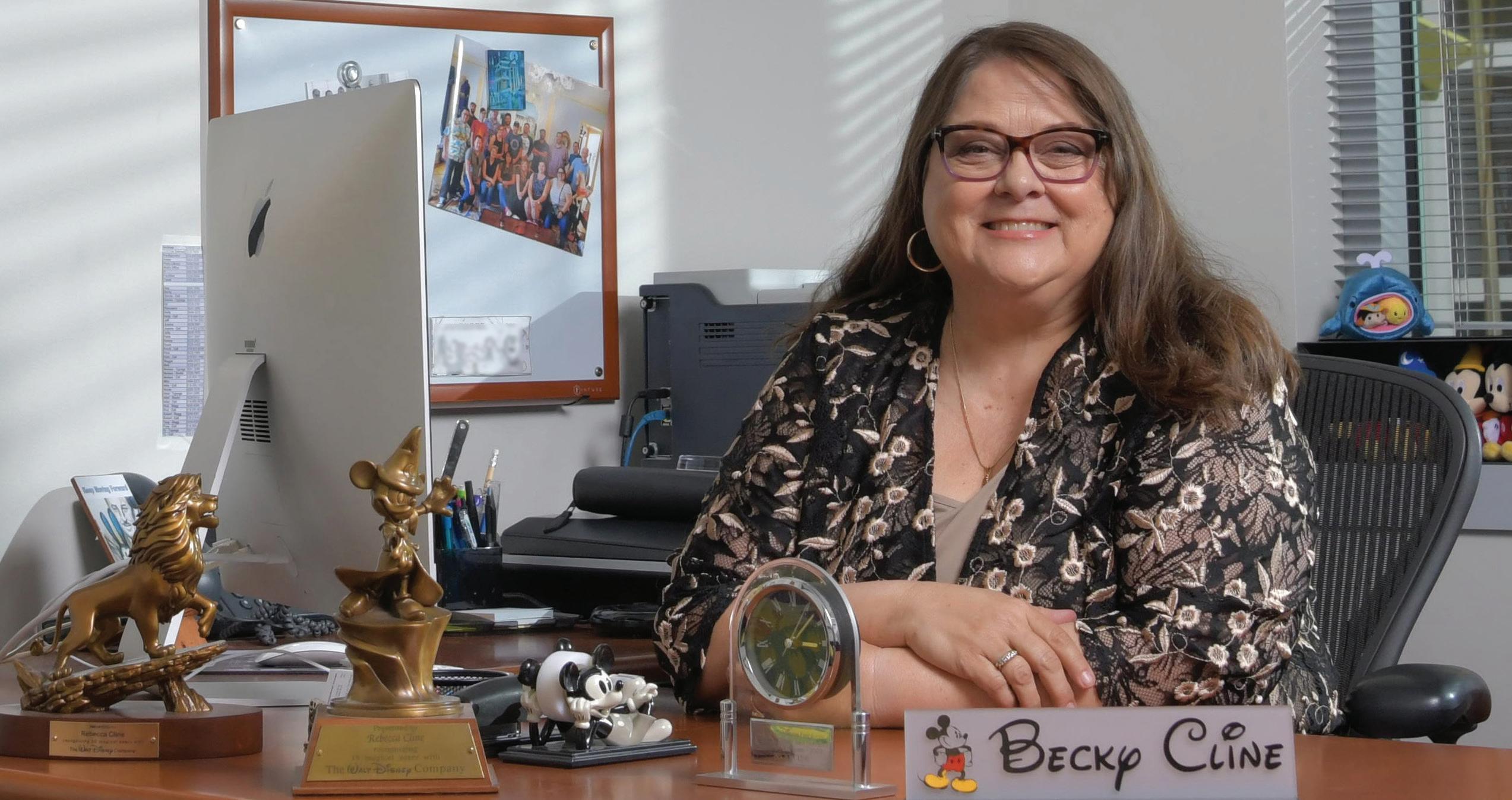
Disney at 100
Written By: Becky Cline, Director, Walt Disney Archives
Just over a century ago, a young man boarded a train from Union Station Kansas City, Missouri, bound for Los Angeles, California, carrying with him a cardboard suitcase containing a reel of film that he'd made as a pilot for a new silent cartoon series. Alice's Wonderland featured a live-action little girl who would have extraordinary adventures in a cartoon world. On October 16, 1923, in his uncle's Hollywood home, that young man signed a contract launching the immediate production of the Alice Comedies cartoon series— and launched a new animation studio. More importantly, it became the foundation of one of the world's most beloved companies—an entertainment empire that has since produced incomparable stories and characters, tales of adventure and discovery, magic, music, and the wonders of history and nature all over the globe. It was the beginning of The Walt Disney Company.
Looking back, it's difficult to think of any other company that uses and shares its own history more than Disney does. Walt Disney's timeless creations are just as popular today as when they debuted many decades ago. The eternally young star who one could argue ushered in the Disney company's prominence, Mickey Mouse, is beloved throughout the world. Mickey and his "sweetheart", Minnie Mouse, made their big screen debut on November 18, 1928, in Steamboat Willie and were an overnight sensation. They were soon joined on the silver screen by their pals Pluto, Goofy, Donald, and Daisy, and became loved the world over, appearing on film, TV, streaming, merchandise and, of course, in person at our theme parks
and resorts.
Animated feature films like Snow White and the Seven Dwarfs (1937), Pinocchio (1940), and Cinderella (1950) followed, and are as fresh and relevant to today's children as they were to their own parents, grandparents, and even great-grandparents who delight in sharing them together as a family. As Walt put it … “We're interested in doing things that are fun—in bringing pleasure and especially laughter to people. And we have never lost our faith in family entertainment stories that make people laugh, stories about warm and human things, stories about historic characters and events, and stories about animals.” That philosophy is just as true today with new classics of animation as well as live-action adventures, comedies, dramas, and real-life stories of courage and truth that are beloved by all members of the family—in all cultures and in every corner of the globe.
To preserve that unique history, and to make it available perpetually, a very special group was founded midway through the last century—the Walt Disney Archives. With the passing of Walt Disney in 1966, his brother (and business partner) Roy O. Disney decided to create a formal archive of the company’s history. He established the Archives in 1970. The mission of the Archives has always been to protect, preserve, and make available for research the history of The Walt Disney Company. Today it is also the mission of the Archives to share that history with fans the world over through publishing, fan events and experiences, and exhibitions.
© Disney © Disney/Pixar © MARVEL © & ™ Lucasfilm Ltd. LLC 5 UnionStation.org


In celebration of Disney's first one hundred years, we at the Walt Disney Archives are thrilled to share a look at our history and Walt Disney’s legacy with Disney100: The Exhibition. When developing this exciting project, we had to decide just exactly how to tell such a massive story. We quickly realized that a chronological history just would not explain the magic that is Disney. The only way was by sharing why Walt Disney did what he did. What his own philosophies were and how they inspired him to create such wondrous productions and experiences.
Throughout the exhibition we present some of the simple philosophies that Walt shared during his amazing career: the importance of storytelling, the addition of personality to beloved characters, the spirit of adventure and discovery, the wonders of the world around us, the magic in beautiful music, and the excitement of experimentation and innovation. These concepts are what made Walt Disney's creations so unique and special, and they are still the heart and soul of the stories and experiences The Walt Disney Company produces today. Through the magic of Disney storytelling, glorious art, the display of iconic and fondly remembered film treasures from Disney’s last 100 years, and brand new educational and entertaining interactives, a tale of enchantment is woven throughout this exhibition, hosted by Walt Disney himself.
As Walt once said, "... there's really no secret about our approach. We keep moving forward–opening up new doors and doing new things–because we’re curious. And curiosity keeps leading us down
new paths. We’re always exploring and experimenting ... When we consider a new project, we really study it–not just the surface idea, but everything about it. And when we go into that new project, we believe in it all the way. We have confidence in our ability to do it right. And we work hard to do the best possible job."
This exhibition represents an extraordinary collaboration between all divisions of The Walt Disney Company, coming together to create this once-in-a-lifetime presentation celebrating how Walt Disney and the company that he and his brother Roy Disney founded have given the world a hundred years of wonder. Its iconic and beautiful objects, art, and media will enchant visitors and present you with an opportunity to learn more about how and (more importantly) why Disney has always remained so special.
We are particularly happy to be bringing Disney100: The Exhibition to Kansas City – the place where Walt developed his own unique and special talents, began his celebrated career in animation and was also a city that was so very dear to his heart. We invite you to this very special experience and ask you to—as Walt himself urged—please join us in celebrating how we intend to "keep moving forward" ... creating new stories, magical realms, and beloved characters that will enchant and delight our audience for centuries to come.
6 Union Station On Track • Disney100: The Exhibition


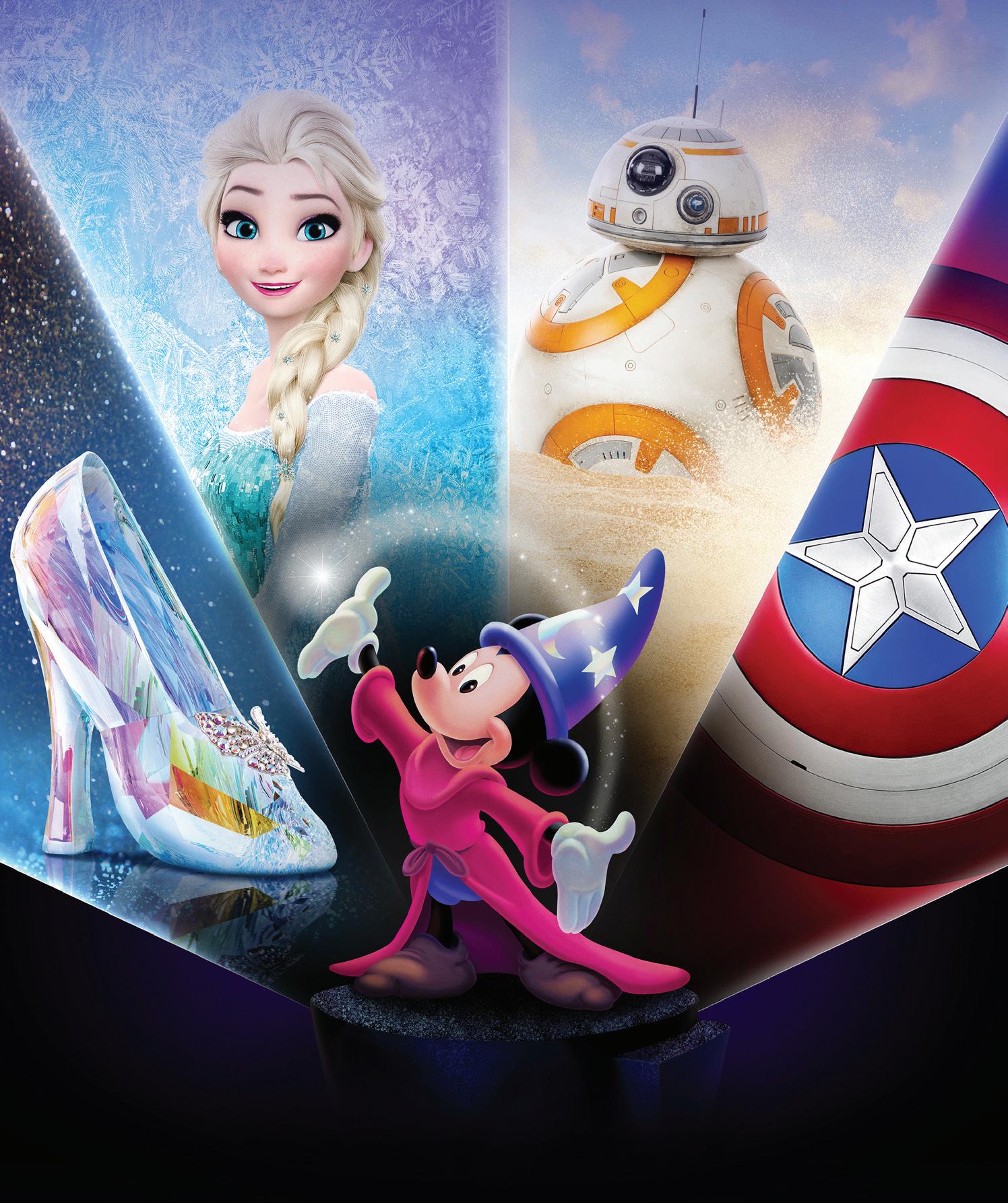
Disney100: The Exhibition—presented in Kansas City by Bank of America—opened at Union Station Kansas City’s Bank of America Gallery on May 24, 2024. Several weeks ahead of the premiere, couriers, designers, archivists, technicians, curators, project managers, and other contributors descended upon the Station to begin the careful process of preparing the space, installing casework, loading video content and interactives, and placing hundreds of treasures from the collections of The Walt Disney Company for opening day.
As you might know, Walt Disney’s roots in Kansas City run deep. In fact, there are few significant Kansas City organizations that Walt didn’t touch during his early “K.C.” years. As a young boy, he delivered newspapers on his father’s paper route and took Saturday drawing classes at the Kansas City Art Institute. He frequented the Kansas City Public Library, where he checked out books on animation. He walked the marble floors and halls of Union Station, often arriving and departing by train. It’s here, in Kansas City, where his budding career as an entrepreneur began—where he met Ub Iwerks and created and marketed some of his first original animated cartoons. And it’s here in our hometown where he honed his storytelling skills and applied his creative passion in a professional sense.
A MAN AND A MOUSE
Walt was born in Chicago, Illinois, on December 5, 1901. His father, Elias Disney, was Irish-Canadian and his mother, Flora Call Disney, was of German-American descent. Walt was one of five children, four boys and a girl.
Raised on a farm in Marceline, Missouri, Walt became interested in drawing from an early age, sketching for neighbors when he was only seven years old. His talent for drawing and love of nature and animals became a touchstone for the rest of his life.
The Disney family would leave Marceline and move to Kansas City, Missouri, in 1911. Here, young Walt would sometimes rise at 3:30 in the morning to deliver newspapers on his father’s paper route. He attended Saturday drawing classes at the Kansas City Art Institute, and at fifteen, he worked on the railroad selling magazines and peanuts. During his time in Kansas City, Walt discovered and fell in love with animation.
In 1918, Walt attempted to enlist for military service. Rejected because he was only 16 years of age, Walt eventually joined the Red Cross and was sent overseas, where he spent most of a year driving an ambulance and chauffeuring officials. His ambulance was eventually covered with drawings and cartoons. Walt’s creativity was evident in everything he touched.
Sponsored by: 7 UnionStation.org





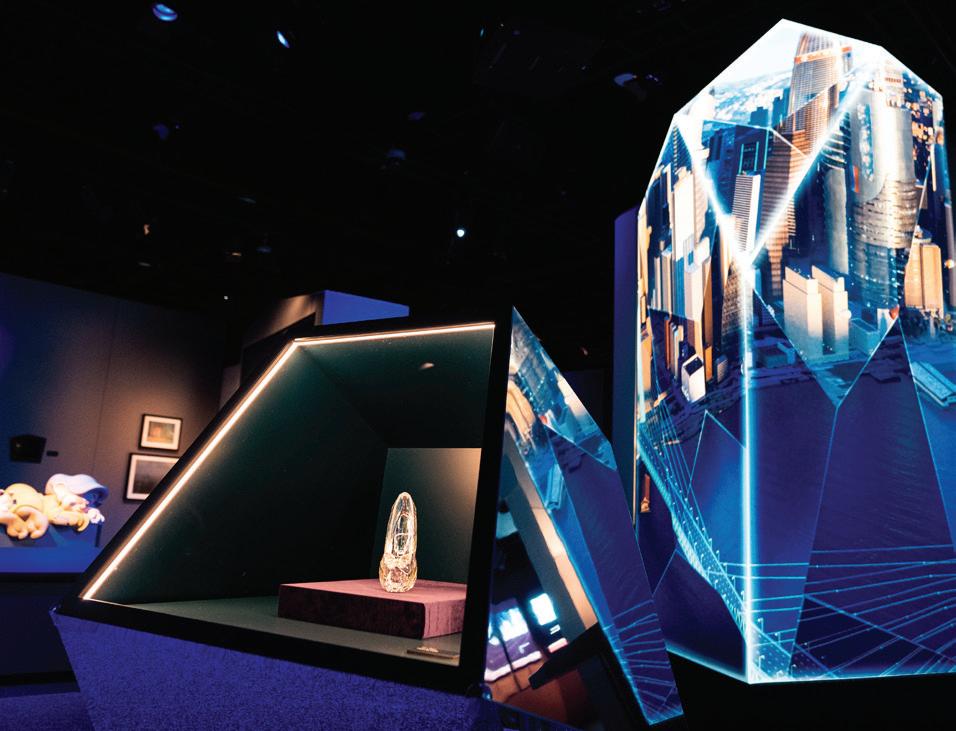

In 1919, Walt returned to Kansas City and began pursuing his dreams. He started his career as an advertising artist, and in 1920, he created and marketed his first original animated cartoons, later conceiving a new method for combining live-action and animation. Before leaving Kansas City for Hollywood in the summer of 1923, Walt made a “pilot” film with four-year-old Virginia Davis as Alice who, with the magic of animation, stepped into a cartoon world. The roots of Hollywood animation were established.
Heading west, Walt had but a few drawing materials, $40 in his pocket, and his animated and live-action pilot film, Alice’s Wonderland. Walt’s older brother Roy O. Disney was already in California with an immense amount of sympathy and encouragement, and $250. Pooling their resources, they borrowed an additional $500 and constructed a camera stand in their uncle’s garage. Soon, they received an order from a distributor in New York for the first in a series of “Alice Comedy” short films, which propelled the brothers into their production operation in the rear of a Hollywood real estate office.
Five years later, in 1928, Mickey Mouse changed the world. Mickey made his big screen debut in Steamboat Willie, the world’s first fully-synchronized sound cartoon. And as the saying goes, “the rest is history.”
During his 43-year Hollywood career, which spanned the development of the motion picture medium as a modern American art, Walter Elias Disney, a modern Aesop, established himself and his product as a genuine part of Americana. A pioneer and innovator, and the possessor of one of the most creative imaginations the world has known, Walt, along with his team, received more than 950 honors and citations throughout the world, including 48 Academy Awards® and 7 Emmys® in his lifetime.
“I only hope that we never lose sight of one thing–that it was all started by a mouse.”
– Walt Disney


But we know that it really all started with a man and a dream. A dream that became a story. A story now being told in an entirely new way . . .
A VERY SPECIAL STORY – 100 YEARS IN THE MAKING Disney storytelling is inspiring and magical. It elicits both laughter and tears, hopes and dreams. It makes one think of a better world—one of possibilities previously unimaginable. And it is with that hope and inspiration that Disney100: The Exhibition was created. Step into the magical worlds of Disney—into the story of The Walt Disney Company—and explore 100 years of storytelling, magic, and wonder.
“We at the Walt Disney Archives are incredibly excited to present this new and unique exhibition marking a century of unparalleled innovation and storytelling, celebrating the wonder of Disney, from 1923 to present and on into the future,” says Becky Cline, Director of the Walt Disney Archives. “With such a rich and varied legacy to draw upon, the exhibit shares the story of the world’s foremost entertainment company through the lens of Walt Disney’s own philosophies, inspirations, dreams, and hopes for a better world. We are thrilled to have the incredible opportunity to showcase how Walt still inspires and informs new generations of storytellers at Disney, and to provide a glimpse of the wonders yet to come in the next century of Disney magic.”
Filling the expansive, state-of-the-art, 20,000-square-foot Bank of America Gallery at Union Station with more than 250 objects and artifacts across ten imaginatively themed galleries, The Walt Disney Company has opened its vaults of treasure to showcase works of art, costumes and props, and Disney memorabilia.
i
8 Union Station On Track • Disney100: The Exhibition








KEY EXHIBITION FEATURES INCLUDE:
• Many of Disney’s Treasures including more than 250 works of art, artifacts, memorabilia, costumes, and props from the collections of The Walt Disney Company.
• Original costumes for characters such as Cruella (Cruella, 2021), Captain Barbossa (Pirates of the Caribbean: The Curse of the Black Pearl, 2003), Black Panther (Black Panther, 2018), and Ariel (The Wonderful World of Disney Presents The Little Mermaid LIVE!, TV, 2019)
• Authentic film props include:
• Prop storybooks from Snow White and the Seven Dwarfs (1937) and Sleeping Beauty (1959)
• Prop spell book from Hocus Pocus (1993) used by Bette Midler
• Cinderella’s glass slipper from the 2015-live action film
• Skywalker lightsaber hilt used by Daisy Ridley in Star Wars: The Rise of the Skywalker (2019)
• Dinglehopper from The Little Mermaid (2023) used by Halle Bailey
• Imaginative photo opportunities featuring depictions of beloved characters, such as Goofy and the Fairy Godmother from Cinderella (1950)
• A wide selection of artwork and three-dimensional maquettes showing the journey of animated characters and stories from concept to screen


Visitors will encounter objects and artwork from some of their favorite Disney films, such as Encanto (2021), and more from across The Walt Disney Company, including Pixar, MARVEL, Star Wars, and National Geographic. The exhibition also features more than 14 interactive installations, offering new ways to experience the magic of Disney and the stories that have impacted generations—spanning 100 years.
Walt’s philosophies are woven throughout Disney100: The Exhibition. Over the last 100 years, those philosophies have inspired Disney creations and stories that, in return, inspire and bring people together. They illuminate the world around us, create treasured memories, and are, at their essence, Disney magic.
We are all dreamers, and the magic of what’s possible, of making dreams come true, appeals to all of us. Disney100: The Exhibition explores the legacy of beloved characters, stories, and experiences that spark the imagination of all who visit.
“Somehow I can’t believe there are many heights that can’t be scaled by a man who knows the secret of making dreams come true. This special secret, it seems to me, can be summarized in four C’s. They are Curiosity, Confidence, Courage, and Constancy and the greatest of these is Confidence. When you believe a thing, believe it all over, implicitly and unquestioningly.” – Walt Disney
Walt’s philosophies still hold true today and guide us ever forward: encouraging us to learn from the past, embrace the present, and imagine what could be in the future.
9 UnionStation.org

EXHIBITION DATES
May 24, 2024 – November 30, 2024
ADMISSION PRICES (Excluding taxes and fees)
Adult: $25
Seniors: $22.50
Child: $20
Group (Non-School): $15
Group (School): $10
Members: $18.50
HOURS OF OPERATION
Summer Hours (May 24 – September 2, 2024)
Sunday: 11am – 5pm
Monday – Friday: 10am – 6pm Saturday: 10am – 7pm
Fall Hours (September 3 – November 30, 2024) Sunday: 11am – 5pm Monday – Saturday: 10am – 5pm







For more information, visit UnionStation.org. WHAT
ARE SAYING Disney100: The Exhibition is brought to you by the Walt Disney Archives and Semmel Exhibitions and presented at Union Station Kansas City by Bank of America. Disney100: The Exhibition supporting sponsors include Hallmark, Kansas City Zoo and Aquarium, University of Missouri Kansas City, NTDF, JE Dunn, Spectrum Paint, and Westin Crown Center Hotel. SCAN TO BUY TICKETS! 0 Article Sources: https://kchistory.org/faq/what-walt-disneys-connection-kansas-city https://d23.com/walts-quotes/ https://d23.com/about-walt-disney/ https://www.waltdisney.org Disney100: The Exhibition Press Kit Disney100: The Exhibition Partner Brochure The magic of Disney comes alive in a brand-new way. – Good Morning America A global celebration of everything that is Disney – 6ABC Philadelphia A visual and auditory feast. – The Philadelphia Inquirer 10 Union Station On Track • Disney100: The Exhibition
FANS

Walt Disney’s Marceline
Walt Disney, the legendary filmmaker, producer, and cofounder of what is now The Walt Disney Company, is one of the most recognized and celebrated figures in the entertainment industry. Many people, however, are unaware of the profound influence Walt’s childhood had on his work. Born in Chicago, Illinois, in 1901, Walt spent his childhood, from age 4 to 9 years old, in Marceline, Missouri, a small town—just a few hours from Kansas City—that he cherished. In fact, Walt infused some of his favorite memories of Marceline into countless aspects of his television, film, and theme park projects.
In this, we will take a closer look at Walt Disney’s childhood in Marceline and how it helped shape the man who would become one of the most beloved figures in entertainment history.
RIDING THE RAILS
Marceline is a town built by the railroad. Without the railroad, there would be no Marceline. The town was founded in 1888 by the Santa Fe Railway as a division point on its Kansas City-Chicago route. The name, Marceline, came at the
request of a director of the new railway whose wife had the name Marcelina. Marceline’s historic Santa Fe depot now houses the Walt Disney Hometown Museum.
Walt Disney not only first arrived in Marceline by train, but it was also in Marceline that Walt developed his lifelong love for all things trains and railroads.

THE DISNEY FAMILY FARM
It was on the family farm in Marceline that a young Walt Disney enjoyed a childhood of outdoor wonderment. Too young to be responsible for any major farm work, Walt and his younger sister, Ruth, found a deep connection to the farmland. On the Disney farm, Walt held his first live show, developed his love for nature, and daydreamed.
At the turn of the next century, the Disney barn in Marceline was rebuilt by local residents in celebration of Walt’s 100th birthday. Although the land is privately owned, guests are invited to visit the barn and leave their signature or note for Walt alongside other fans and dreamers.
11 UnionStation.org
Photos Courtesy of Walt Disney Hometown Museum
WALT DISNEY ELEMENTARY SCHOOL
In 1960, Walt Disney personally came to dedicate the new elementary school in Marceline. Walt donated educational films, projection equipment, and state-of-the-art playground equipment. He asked Disney studio publicity artist—and future Disney Legend—Bob Moore to create murals featuring some of the most famous Disney characters. These murals are regularly restored and are still displayed today. At the 1960 dedication ceremony, Walt presented the school with an orange Mickey Mouse flag that had been flown over his apartment at Disneyland. He also presented the school with a flagpole from the 1960 Winter Olympics, for which he was the chairman of the Pageantry Committee. The flagpole still stands, and the original Mickey Mouse flag is now displayed in the Walt Disney Hometown Museum.
WALT DISNEY POST OFFICE
In 1968, the United States Postal Service issued a six-cent stamp commemorating Walt Disney (just two years after his passing), and Marceline was chosen as the location where these stamps would first be issued. Many years later, in 2003, Congress officially renamed this location the Walt Disney Post Office, the only federal building named after Walt.
WALT DISNEY MUNICIPAL PARK
Originally built by the Santa Fe Railroad, this park was officially renamed the Walt Disney Municipal Park in 1956. Walt and his brother Roy O. Disney were on hand for the dedication ceremony. The park is the town’s original location of the Walt Disney Swimming Pool and Midget Autopia, a 1957 Disneyland® Park attraction that Walt donated to the city in 1966 (it can now be found in E.P. Ripley Park).
MAIN STREET, U.S.A.
Main Street, U.S.A. is a staple of Disney Parks around the world, and its inspiration has roots in Walt’s memories of Marceline. When young Walt lived there, Marceline’s “main street” was known as Kansas Avenue. In 1998, Marceline officially adopted the name Main Street, U.S.A., as a tribute to Walt and his legacy, complete with special street signs and a visit by Mickey Mouse himself.
E. P. RIPLEY PARK
E. P. Ripley was the president of the Atchison, Topeka, and Santa Fe Railway. As an honor to him, the Santa Fe Railway built the Marceline city park in his name. The Disney family visited this park often during their time in Marceline. A steam locomotive was also donated to the park by the Santa Fe. Today, E.P. Ripley Park is home to the restored Midget Autopia track in Marceline.
A visit to Marceline today is a trip down memory lane for many and a treasured discovery for Walt Disney fans from around the world. Over 30,000 visitors annually make their way to the Walt Disney Hometown Museum and the area that helped inspire Main Street, U.S.A. at the Disney Parks. The Museum is open Tuesday through Sunday during the months of March through mid-December. Visit waltdisneymuseum.org to start planning your visit

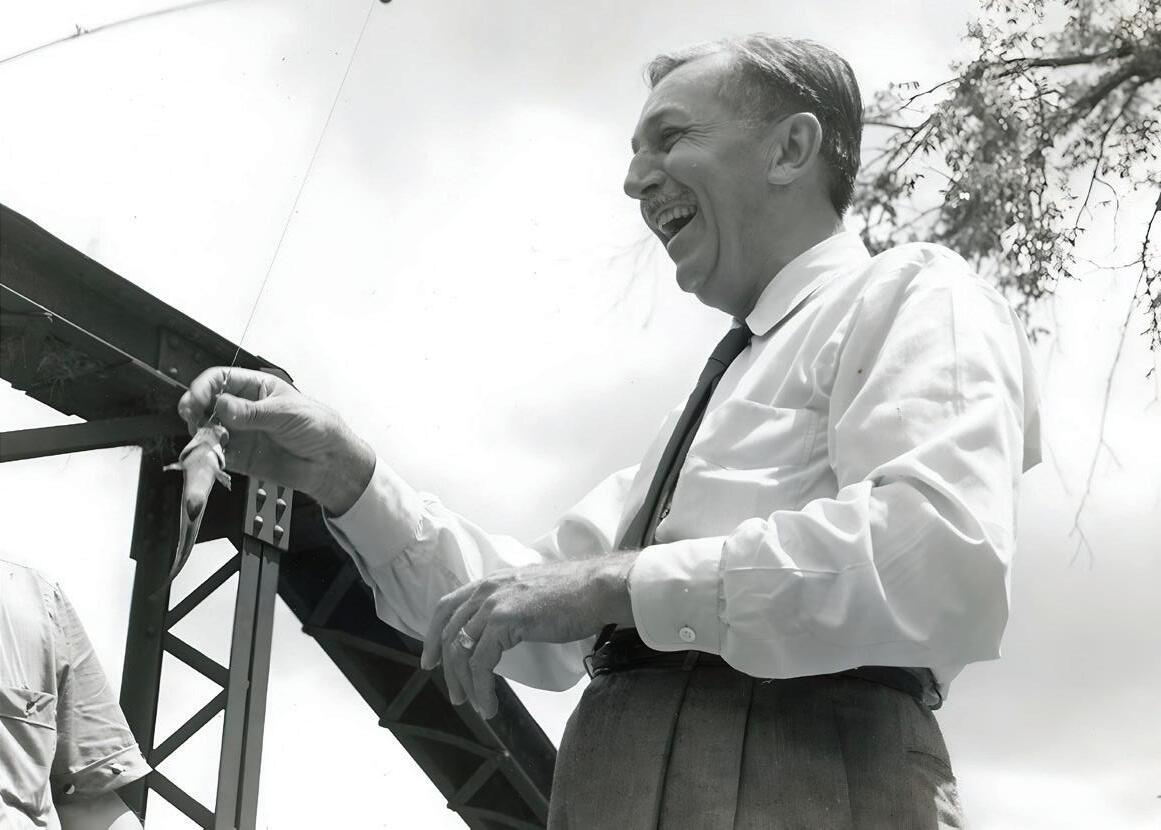

12 Union Station On Track • Disney100: The Exhibition
Walt Disney Remembers Walt Disney Remembers
Recalling his childhood days, Marceline's Favorite Son writes his impressions for the September 2, 1938 edition of The Marceline News:
I was extremely glad to receive your letter asking me to write some impressions as I remember it from my childhood days.
To tell the truth, more things of importance happened to me in Marceline than have happened since - or are likely to in the future. Things, I mean like, experiencing my first country life, seeing my first circus parade, attending my first school, seeing my first motion picture! I know you will agree with me that such childhood "firsts" are of upmost importance in any human beings life.
I went with my family to live in Marceline when I was five years old, and I stayed there until I was nine. I clearly remember the day we arrived on the train. A Mr. Coffman met us in his wagon and we rode out to our new house in the country just outside the city limits. I believe it was called the Crane Farm. My first impression of it was that it had a beautiful front yard with lots of weeping willow trees.
The Taylors lived on one side of us and Doc Sherwood lived on the other, one of my fondest childhood memories is of Doc Sherwood. He used to encourage me, in my drawing, and gave me little presents for my efforts.
One time I think he must have held a horse of his nearly all day so I could draw it. Needless to say the drawing wasn’t so hot, but Doc made me think it was tops.
My brother Roy reminds me of another flyer I took in the line of art at the time. I painted one side of our house with black pitch. The outcome must have been slightly frightening, to say the least, and I wasn’t thanked for my efforts by the family.
I can remember the big red brick school house as if it was yesterday. Maybe if I saw it today it wouldn’t seem so immense, but it did to my young eyes. My first teachers name was Miss Brown.
And what fun we kids used to have after school on winter days, going down the hillsides lickety-split on a sled.
Everything connected with Marceline was a thrill to us, coming, as we did, from a city the size of Chicago. The cows, pigs and chickens gave me a big thrill, and perhaps that's the reason we use so many barnyard animals in our Mickey Mouse and Silly Symphony pictures today - who knows! You know what the psychologist say about the importance of childhood impressions.
A special event in connection with my life in Marceline was the day I got to go down in the old No. 2 coal mine, which was just a short distance from our place.
Before we left Marceline, we moved from the farm into town for a while, where we lived between the Wheelers and the Moormans. Mr. Moorman was the high school principal, and Mrs. Moorman, I must admit was my first "dream girl." Of course, I was all of eight or nine at the time, but I can still remember what pretty red hair she had.
Other random remembrances include the fact that one of the prides in my life was my uncle Mike Martin, who was an engineer on a train running from Marceline to Fort Madison, Iowa. After all, if you can't be an engineer yourself, the next best thing is to have a relative who is one.
I'm glad I'm a small town-boy and I'm glad Marceline was my town. Thanks a lot for letting me write my impressions, and say hello to all the folks. In addition, here is wishing you all congratulations and success in connection with your Golden Jubilee.
Source: 9/2/1938 edition of The Marceline News newspaper, article titled "The Marceline I Knew," page 1.


13 UnionStation.org


Walt Disney's Kansas City
WHERE
HARD WORK MAKES DREAMS COME TRUE
Written by: Dylan Ringer, Kansas City Art Institute, Senior majoring in Painting and Creative Writing
In the early 1920s, long before Walt Disney became a household name synonymous with magic and imagination, his animation career began in the heart of the Midwest—Kansas City. This bustling metropolis served as the backdrop for some of Walt’s most formative years, both in childhood and the beginning of his career. It was a time of artistic exploration, entrepreneurial ambition, and the birth of an animation pioneer.
Kansas City, a city of jazz, fountains, and a burgeoning creative spirit, played a pivotal role in shaping the man who would go on to revolutionize the entertainment industry.
HUMBLE BEGINNINGS
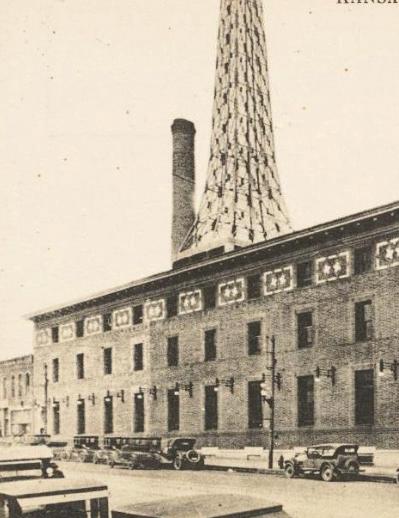

neighborhood was also where Disney had his first job delivering The Kansas City Star and Times newspapers for his father’s paper route. In 1914, the family settled into a two-story home at 3028 Bellefontaine, still standing in Kansas City today, not as a museum, but as a simple family residence. The garage of the Bellefontaine house had served as Walt’s first animation studio—back when the potential of animation lived only in his experimental ideas. In 1916, Walt began taking Saturday drawing classes at the Kansas City Art Institute.
A CITY OF DREAMS
Kansas City in the 1920s was a city of dreams, a melting pot of culture and creativity. Disney caught the very beginning of what has been referred to as the “Golden Age” of Kansas City.
KANSAS CITY PUBLIC LIBRARY

Walt Disney was born in Chicago, Illinois, but in 1906, moved with his family to Marceline, Missouri. A farm town in northern Missouri, Marceline is considered Disney’s “hometown,” with a museum there dedicated to his memory. Throughout his life, Walt insisted upon his idyllic, rural upbringing being a key source of his character. Arriving in Kansas City in June 1911, was a major shift for nine-yearold Walt, with the city much larger than any place he could remember. Walt Disney and his family first settled into a small, rented house at 2706 E. 31st Street, and he attended Benton Grammar School that fall. This
During his downtime, Walt would often explore the streets of Kansas City. One of his frequent stops was the Kansas City Public Library, which quickly became a resource for his artistic passion. Walt Disney was able to study the newly published Animated Cartoons –How They Are Made, Their Origin and Development by E.G. Lutz, and Animals in Motion by Eadweard Muybridge at the library. These books are likely one reason Disney pursued the moving picture over his original love of comics. Muybridge’s book is still on display at the Central Library branch on W. 10th Street.
ELECTRIC PARK
A popular attraction in pre-World War I Kansas City, Electric Park featured some 100,000 lights that ensconced its buildings,
14 Union Station On Track • Disney100: The Exhibition
Photos Courtesy of Kansas City Art Institute




along with water fountain light shows, fireworks, and a train that encircled the park. Although it burned down in 1925, while Disney was a boy it was a streetcar’s ride away from his neighborhood, opening near 46th Street and The Paseo.

UNIVERSITY OF MISSOURI-KANSAS CITY
Kangaroos became the official mascot of UMKC largely due to Walt Disney. In 1936, the university was trying to determine a mascot suited to their debate team, and many students, inspired by the Kansas City Zoo’s recent acquisition of two new baby kangaroos, thought it was a sign that kangaroos were meant to be. The trend spread over their campus like wildfire, and later, a newly published humor magazine, dubbed The Kangaroo, wrote to Walt Disney to ask him to design an emblem for their school. He obliged, and his studio designed an early version of the presentday UMKC mascot, Kasey, the Kangaroo.
In 1917, Walt’s father, Elias Disney, moved the family back to Chicago in pursuit of better business opportunities. While working as a news butcher on the railroad, and joining the Red Cross in Europe the following year as an ambulance chauffeur, Walt Disney got to experience more of the world, all backed by the clear intention of one day becoming a cartoonist. While in


Chicago, he enrolled in night classes at the Chicago Academy of Fine Arts, which gave him access to professional cartoonists. Returning to Kansas City in 1919, Walt Disney was able to temporarily move back into his childhood home on Bellefontaine, with his older brothers Herbert and Roy.
THE KANSAS CITY ART INSTITUTE CONNECTION
While Walt Disney did not graduate from the Kansas City Art Institute, he held onto his connections with the Institute through to the last years of his life.
Walt Disney, at 14 years old, was attending the Institute’s weekend art classes up until 1917 when his family left Kansas City to return to Chicago. Even though his father did not support art as a career, by framing the classes at the Art Institute as an educational opportunity, Disney was able to gain his support.
In 1959, he sent his touring exhibit to the Art Institute called “The Art of Animation,” on the eve of the college’s 75th anniversary. This display was also showcased at Disneyland, with additional units touring Asia and Europe, and highlighted the Disney studio’s process of making animated films.
In 1963, Walt returned to Kansas City to receive a distinguished alumnus award, stating he owed his formative knowledge to the Kansas City Art Institute.
PESMEN-RUBIN COMMERCIAL ART STUDIO
Finding work that aligned with Walt Disney’s passion for cartooning proved to be difficult upon his return to Kansas City;
15 UnionStation.org
Courtesy: Kansas City Art Institute


the local papers didn’t have any available cartoonist positions, and the Kansas City Star didn’t even want Disney as an office assistant. His brother Roy informed Disney of a potential job opportunity in advertising. Working under the Pesmen-Rubin art studio, he was introduced to the business side of art in Kansas City. Illustrating advertisements, Disney continued to refine his craft and found new ways to look at the production of art, like the difference between fine art’s desire for perfection, and the industry’s need for efficiency. While working for Pesmen-Rubin, he designed advertisements for the newly constructed Newman Theatre at 1116 Main Street. This theater was not only one of the grandest in Kansas City, but it was also where Walt Disney would later show his early animated films, titled Newman Laugh-O-grams, in 1921.
THE KANSAS CITY FILM AD COMPANY
In 1920, Walt Disney’s journey brought him to the Kansas City Slide Co. at 1015 Central Street. The company soon thereafter moved to 2449 Charlotte with the new name, Kansas City Film Ad Company. This company served as a small film studio, producing pre-feature advertisements for local businesses. It was here that he first tasted the magic of the moving picture, as Disney became absorbed by animation. Meanwhile, he would recruit teenagers on nights and weekends to work on his own animation projects. They were unpaid but eager to learn the trade of cartooning. Through the job, Disney learned the ropes of film production and honed his storytelling skills later with the Newman Laugh-O-grams. It was also here that he began recruiting the artists that would ultimately make up his first independent studio.

THE BIRTH OF LAUGH-O-GRAM FILMS
In 1922, Disney incorporated Laugh-O-gram Films, Inc., named after the successful pictures he had been showing at the Newman Theatre. Nestled in the heart of Kansas City at 1127 E. 31st Street, this small studio became a hub of creativity and innovation.
Comprised of a team of animation rookies, the whole studio was suspended on a dream which proved to be a total labor of love. But ultimately, they created what some now consider the “cradle of Hollywood animation.” The artists Walt brought in, from his past advertising jobs and through an ad in The Star, would turn out to be some of the leaders of the animation industry in the early 20th century. Hugh Harman, Rudolf Ising, and Carman “Max” Maxwell would later start the Warner Bros. and Metro-Goldwyn-Mayer animation studios. The staff also included Lorey Tague, Alexander Wilson Kurfiss, Otto Walliman, Walt Pfeiffer (one of Walt’s boyhood friends), Adolph “Jack” Kloepper, William McAtee “Red” Lyon, Friz Freleng, George “Jimmy” Lowerre, and, importantly, Ub Iwerks, who had begun working alongside Disney at Pesmen-Rubin.
UB IWERKS
Recognizing Ub Iwerks’ exceptional artistic skills and passion for art, Disney quickly became friends with him. Their partnership began with a short-lived studio in a bathroom above the Restaurant News company, which laid the groundwork for the dynamic duo’s future successes in Hollywood. Ub Iwerks’ contributions to Disney’s projects, beginning during the Laugh-O-gram days, were invaluable. A Kansas City Art Institute graduate, his innovative technical talents helped materialize animation as the medium we know today.

Photos Courtesy of Kansas City Art Institute 16 Union Station On Track • Disney100: The Exhibition
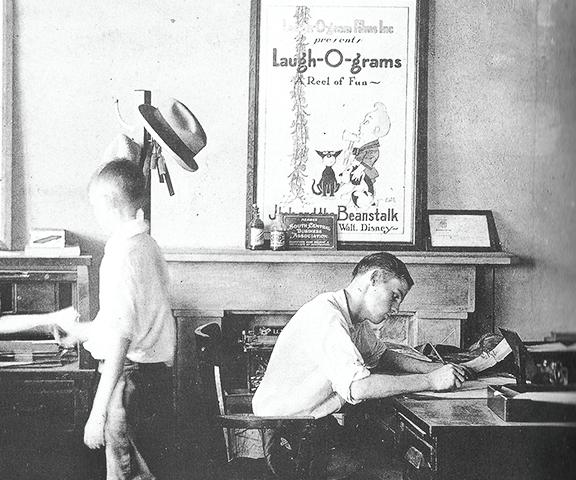
LAUGH-O-GRAM FAIRY TALES
At Laugh-O-gram Films, Disney embarked on modern renditions of fairy tales. His team produced a series of short animated films that marked the early roots of Disney’s animation legacy, showcasing his ability to weave enchanting narratives that captured the imagination with the lighthearted humor he brought to all his productions. The studio produced films such as Little Red Riding Hood and Jack and the Beanstalk (both created in 1922), laying the foundation for the storytelling magic that would later become synonymous with the Disney brand.
CHALLENGES AND LESSONS
However, the path to success was not without its share of challenges. Financial troubles loomed over Laugh-O-gram Films and led to its eventual bankruptcy in 1923. This forced Disney to confront the harsh realities of the business world, marking a temporary setback for his dreams.
THE TRANSITION TO HOLLYWOOD
As Laugh-O-gram Films faced its demise, Walt Disney reflected on the lessons learned and contemplated the next steps in his journey. At the suggestion of his brother Roy, who had moved to a veterans’ hospital in California, Disney made the pivotal decision to venture westward to Hollywood, where new opportunities awaited. This was not the first time Roy and Walt had worked together – although the previous time was about a decade before, when they were both young boys delivering newspapers for their father.
Armed with lessons from Kansas City and fueled by a determination to succeed, Walt Disney set his sights on Hollywood. The move marked


a turning point in Disney’s career, leading to the birth of the Disney Brothers Cartoon Studio, which would later evolve into The Walt Disney Company.
THE LEGACY OF KANSAS CITY
While Walt Disney’s time in Kansas City may have been marked by both triumphs and setbacks, the city left an enduring impact on his creative spirit. The lessons learned, the friendships forged, and the artistic evolution that occurred during those years became the unsung building blocks of the Disney legacy today.
As we trace Walt Disney’s footsteps through the streets of Kansas City, we uncover a tale of resilience, creativity, and unwavering determination. From the humble beginnings at the Kansas City Film Ad Company to the challenges faced at Laugh-O-gram Films, and the pivotal decision to venture to Hollywood, each chapter of Disney’s Kansas City odyssey contributed to the unfolding narrative of one artist's quest to bring magic to the world.
Kansas City, with its vibrant arts scene and pioneering spirit, provided the basin from which the fountain of imagination continues to overflow. Walt Disney found that this city was a place where dreams come true. Today, as we enjoy the enchanting worlds created by The Walt Disney Company, let us not forget the city that played a crucial role in shaping the dreamer who dared to defy convention and reinvent the art of a motion picture.
17 UnionStation.org




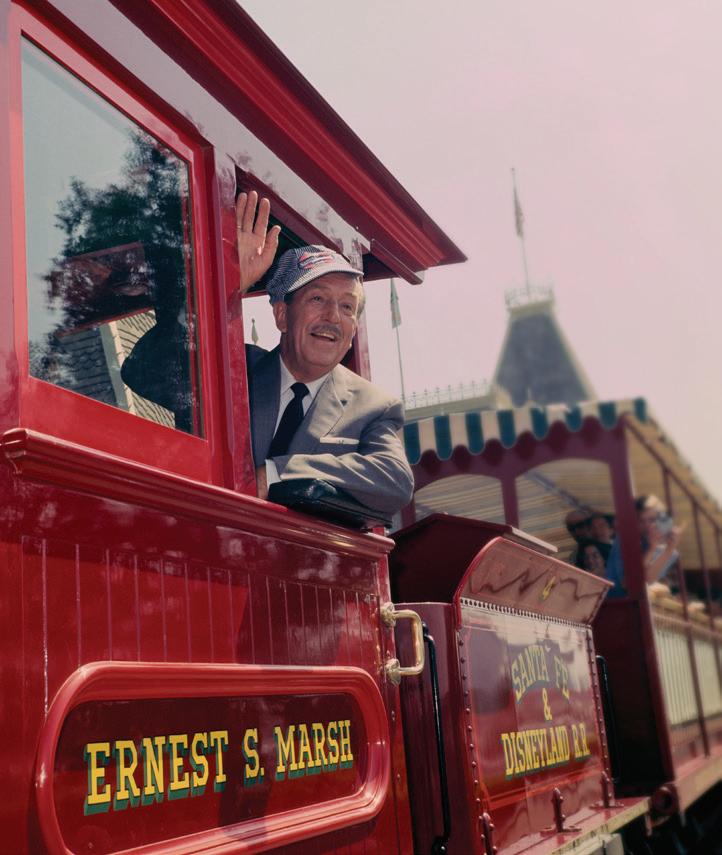


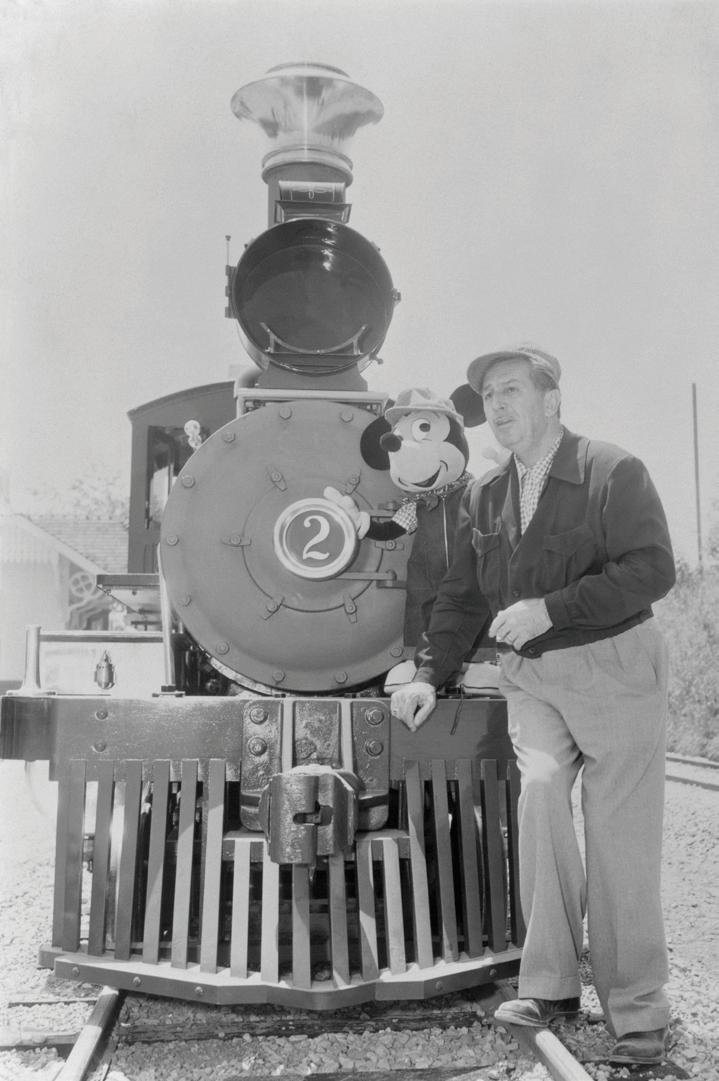


18 Union Station On Track • Disney100: The Exhibition

Walt Disney arrived in California in the summer of 1923 with a lot of hope but little else. He and his brother Roy O. Disney would work on making animated films out of their uncle’s garage and later in the back of a real estate office two blocks away. When New York cartoon distributor Margaret Winkler agreed to fund Walt’s liveaction and animation hybrid shorts, known as the Alice Comedies, Walt and Roy founded the Disney Brothers Cartoon Studio. Their contract with Winkler, signed October 16, 1923, is considered the founding document of The Walt Disney Company.
The Alice Comedies led to more work and a reputation for quality storytelling with heart. This earned the young, ambitious Disney brothers their biggest project yet: a deal with Universal Pictures for shorts featuring a long-eared hero named Oswald the Lucky Rabbit. Premiering in 1927, Oswald quickly became popular enough to inspire his own branded merchandise. The next year, Walt and his wife, Lillian, took a train to New York to renegotiate the Oswald contract and instead found themselves leaving with no contract and no character. The rights to Oswald belonged to Universal, and the series’ distributor refused to offer Walt reasonable terms for a renewal. On the train back to Los Angeles, as Walt later told the

THE HISTORY of THE WALT DISNEY COMPANY
story, he thought up a mouse character: a mischievous and lovable character he considered naming Mortimer. Walt’s wife, Lilly, thought Mortimer was a terrible name and suggested he be renamed Mickey instead.
The public first met and fell in love with Mickey Mouse in Steamboat Willie in 1928, which made history as the world’s first cartoon with fully synchronized sound. Mickey Mouse quickly became an international phenomenon, with animated shorts, a comic strip, and merchandise bearing Mickey’s optimistic outlook. Minnie Mouse accompanied him from the beginning, and he soon gained new co-stars, including a dog, later named Pluto, in 1930, the gawky and comic Goofy in 1932, and the irascible Donald Duck in 1934. In 1932, Walt was honored with a special Academy Award® for creating Mickey Mouse. Over the next 90 years, The Walt Disney Company would take home some 150 Academy Awards. Walt’s eventual total of 32 personal Academy Awards is a record that still stands today.
Continuing to advance the art of animation, Disney introduced the three-strip Technicolor process in animation with Flowers and Trees in 1932. Walt took animation another giant step forward with
19 UnionStation.org
Courtesy: Walt Disney Archives

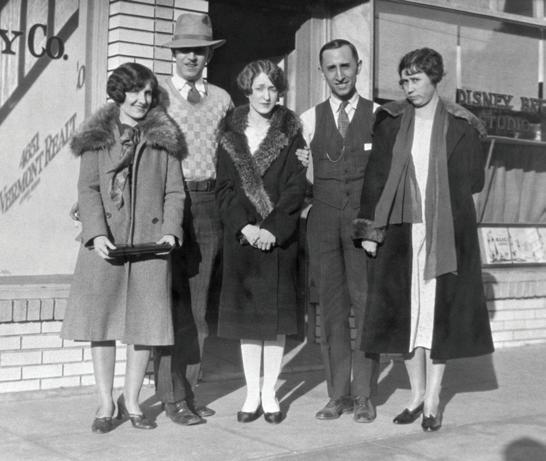
the December 1937 premiere of Snow White and the Seven Dwarfs, the first full-length animated film, after more than three years of work. It became an unprecedented success and led the studio into the new business of making feature films. Pinocchio (1940), Fantasia (1940), Dumbo (1941), and Bambi (1942) soon followed.
Production was disrupted by World War II, and the company pitched in with training films and many other contributions. After the war, the studio returned to feature filmmaking, creating in quick succession the classics Cinderella (1950), Alice in Wonderland (1951), and Peter Pan (1953). At the same time, the studio expanded further into live-action filmmaking, with both groundbreaking documentaries under the True-Life Adventures banner—starting with the Oscar®winning Seal Island (1948)—and scripted films such as Treasure Island (1950) and the award-winning 20,000 Leagues Under the Sea (1954).

After almost a year of construction—and years of dreaming from Walt—Disneyland opened on July 17, 1955. It was the world’s first theme park, another of “Disney’s follies” that struck a chord with a global audience.
At the same time, Disney expanded into television, which other Hollywood studios considered their competition. The TV series Disneyland (later Walt Disney’s Wonderful World of Color, among other titles) debuted in 1954, introducing its millions of viewers to the concepts that would define Disneyland. Popular television shows
including the Mickey Mouse Club and Zorro would soon follow.
In the early 1960s, Walt and his Imagineers then turned their attention eastward, to the 1964-1965 New York World’s Fair, where they created four of the most artistic, engaging, and popular attractions and presentations, including “it’s a small world” and the hyper-realistic Audio-Animatronics® figure at the center of Great Moments with Mr. Lincoln.
This period also produced perhaps the most cherished and acclaimed live-action film in the company’s first century, Mary Poppins (1964), transforming a beloved series of British children’s stories into an unsurpassed and Oscar-winning musical, with unforgettable songs by Disney Legends Richard M. and Robert B. Sherman. Just a couple of short years later, on December 15, Walt Disney passed away at age 65.
Walt had initiated the “Florida Project” in the early 1960s as a way to expand beyond his ambitions for Disneyland. Over a period of about 18 months, Disney had quietly purchased more than 27,000 acres of Central Florida land to provide enough space for anything Walt and his Imagineers could dream up, and the project was announced in late 1965. After Walt’s passing, Roy, then in his 70s, postponed his retirement to shepherd the massive resort plan to completion. To honor his brother, Roy insisted the development be called Walt Disney World—and just months after the Magic Kingdom’s October 1971 opening, Roy, too, passed away.
For the first time without a Disney brother in charge, the company was guided by future Disney Legends Donn Tatum (as chairman and CEO) and Card Walker (as president). The last animated feature that Walt personally oversaw, The Jungle Book (1967), was followed by more family classics.

Another leadership change took place in 1980, as Walker became chairman and Walt Disney’s son-in-law, Ron W. Miller, became president, then CEO in 1983. The home video boom was just beginning, and Disney launched the first in its successful series of releasing animated features on VHS with Dumbo in 1981. Two years later, The Disney Channel debuted, foreshadowing decades of innovation in delivering storytelling directly to audiences’ living rooms. Proving that the legacy of Walt Disney himself would continue, EPCOT Center opened in 1982, inspired by Walt’s own vision of a community of the future. A year later, Tokyo Disneyland opened, the company’s first international theme park.
20 Union Station On Track • Disney100: The Exhibition
In 1984, Michael Eisner took over as CEO and future Disney Legend Frank G. Wells as president and COO, with a commitment to the company’s traditional strengths—animation, filmmaking, and theme parks—as well as building up newer businesses, such as retail (the first Disney Store opened in 1987), home video, and television. Eisner and Wells also sealed a deal with the French government to create Disney’s first European theme park, known today as Disneyland Paris.

In 1989, the Disney-MGM Studios Theme Park (now Disney’s Hollywood Studios) opened at Walt Disney World. Then, in November, came The Little Mermaid, a triumphant return to fairy tale storytelling for Walt Disney Feature Animation—now Walt Disney Animation Studios—under the division’s leader, Disney Legend Roy E. Disney, the son of Roy O. Disney. Beauty and the Beast followed in 1991 and earned the first-ever Best Picture Oscar nomination for an animated film. In 1991 Disney signed a distribution deal with a small computeranimation production company named Pixar.

In 1994, Disney animation enjoyed its biggest hit ever to that point with the debut of The Lion King, which became the year’s most popular film. It was followed the next year by Disney and Pixar’s trailblazing CG feature Toy Story, a smash that topped the box office chart for 1995. Meanwhile, Beauty and the Beast became the first animated film
to arrive on Broadway as a hit stage musical, soon followed by The Lion King and other Tony Award®-winning productions. The company’s expansion hit a major milestone in 1995 with the acquisition of Capital Cities/ABC, as well as leading cable TV sports network ESPN. Then, expansion hit another peak in 1998, as a fourth theme park, Disney’s Animal Kingdom, opened at Walt Disney World Resort, and the company launched Disney Cruise Line. Two new theme parks opened in 2001—Disney California Adventure in Anaheim and Tokyo DisneySea in Japan—and in 2004, The Muppets officially became part of the Disney family.
When Bob Iger became CEO in 2005, he announced three areas of focus for the company: advancing creativity through the development of the best intellectual property, remaining at the forefront of technological innovation, and ramping up international expansion. Iger took over just weeks after one prominent example of the company’s international vision came into focus: the opening of Hong Kong Disneyland. The next year, Iger made good on assembling the best intellectual property with the purchase of Pixar Animation Studios, which soon released the hits Cars (2006) and Ratatouille (2007). Then came the phenomenal success of High School Musical on Disney Channel and Pirates of the Caribbean: Dead Man’s Chest at theaters in 2006; the latter stood as the company’s highest-grossing live-action feature ever until the release of 2017’s Beauty and the Beast
In 2009, the company launched D23: The Official Disney Fan Club, designed to provide Disney’s most loyal fans with exclusive content and incredible experiences. Iger continued to expand the company’s creative portfolio with the acquisition of Marvel Entertainment in 2009 and Lucasfilm in 2012. With the opening of a third Asian theme park destination, Shanghai Disney Resort, in 2016, Walt Disney Imagineering set a new standard for theme park design.

The Walt Disney Company bookended 2019 with several major additions, starting with the acquisition of 20th Century Fox in March, and then the remarkable launch of Disney+ in November, finding immediate success with its deep library and original series such as Lucasfilm’s The Mandalorian.
For more than a century now, The Walt Disney Company has created entertainment of the highest quality. From humble beginnings as a cartoon studio in the early 1920s to the company of today, Disney continues to provide timeless entertainment for the entire family.
21 UnionStation.org

DISNEY LOCALS, LEG
Bret Iwan

Bret Iwan began his career in the entertainment industry in Kansas City over fifteen years ago. Despite being self-taught, he quickly proved to be a talented and versatile voice actor. While he is best known as the official voice of Mickey Mouse, a role he took on after the passing of Disney Legend Wayne Allwine in 2009, Bret has also demonstrated an impressive array of talents throughout his career.
Born on September 10, 1982, in Pasadena, California, Bret’s passion and love for Disney grew naturally. Many core childhood memories included his family and the one-and-only Mickey Mouse. He would spend his time mimicking the famous mouse while putting on shows for his loved ones, who often remarked on his talent.
Bret’s passion for Disney led him to pursue a Bachelor of Fine Arts degree from Ringling College of Art and Design in Sarasota, Florida. After graduating, he moved to Kansas City and began his career at Hallmark Cards, Inc. as an illustrator and designer in 2004.

In 2009, Bret received an email from a college friend (who had since become an animator at Pixar Animation Studios) about auditions to understudy the voice of Mickey Mouse. Not wasting a moment, Bret practiced and submitted his recorded phone audition. After several weeks of ongoing auditions and phone calls, Bret was finally offered the role as the fourth official voice of Mickey Mouse.
Since then, Bret has embraced the role with enthusiasm and skill. His voice can be heard across numerous Mickey Mouse projects, including the popular television series Mickey Mouse Clubhouse (2006–2016) and Mickey and the Roadster Racers (later known as Mickey Mouse Roadster Racers and Mickey Mouse Mixed-Up Adventures) (2017–2021). He has also voiced Mickey in a variety of consumer products and video games, productions for Disney theme parks, and countless other projects for The Walt Disney Company. Over the years, Bret has made notable appearances at Disney special events across the globe, bringing joy and excitement to thousands of fans.
“Mickey has influenced my personality more than I could ever imagine,” Bret reflects. “Mickey is charismatic, loyal, a great friend and so much more. You cannot help but be influenced by that. The importance of the role is not lost in me.”
Bret’s artistic talent extends beyond his work as the voice of Mickey. He also creates giclées on canvas featuring Mickey in national parks like the Grand Canyon, Yellowstone, Yosemite, and more. Recently, Bret had the honor of being the eighth artist to create an official birthday portrait of Mickey Mouse, which was unveiled in 2023. This display of creativity and passion for the iconic character which will be showcased in Disney100: The Exhibition
22 Union Station On Track • Disney100: The Exhibition

ENDS AND LUMINEERS
Ub Iwerks

A Kansas City native, Ub Iwerks would be known at the Disney studio for his animation genius and technical wizardry—as well as his uncommon name. Ubbe Eert Iwwerks was born to German-American parents on March 24, 1901, in Kansas City, Missouri. In 1919, he met fellow employee Walt Disney at the Pesmen-Rubin Commercial Art Studio. Both were 18 years old when, after being laid off, they decided to open their own business. Called Iwwerks-Disney Commercial Artists (“Disney-Iwwerks,” they decided, sounded too much like an eyeglass manufacturer), the enterprise lasted only a month before they both accepted jobs at the Kansas City Slide Company.
In 1922, when Walt formed Laugh-O-gram Films, Ub joined him as principal animator. The studio went bankrupt, however, and, two years later, Ub followed Walt to Hollywood. There, he joined the Disney Brothers Cartoon Studio to help produce the Alice Comedies series.
Ub is credited with animating Mickey Mouse for the first time, and he brought the character to life with record-breaking speed. In fact, he animated the first Mickey Mouse silent cartoon, Plane Crazy, entirely by himself within a three-week period, completing as many as 700 drawings a day. (For the most recent hand-drawn films, the average animator produces 80 to 100 drawings a week!)
invented technology that would revolutionize feature animation. One of his creations was the multi-head optical printer, used to combine live-action and animated footage in such films as Melody Time (1948). In the late 1950s, Ub’s modified Xerox process allowed animators’ pencil drawings to be transferred directly to cels without the more time-consuming hand-inking.
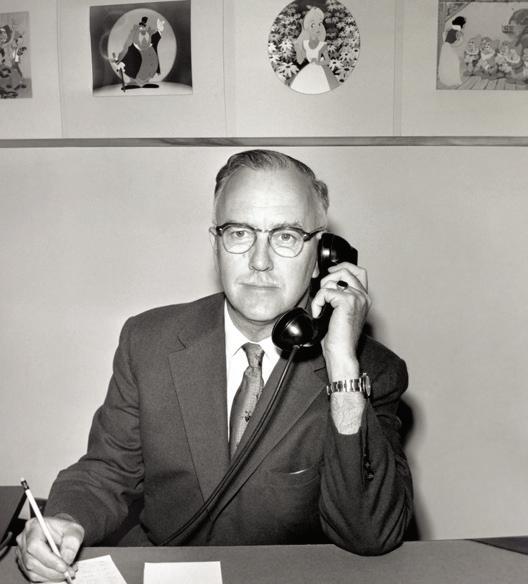
In 1929, Ub served as directing animator for the brand-new Silly Symphony short film series, before branching out on his own the following year.
After a decade, Ub returned to the Disney studio, where he focused on technical development. As Disney’s resident technical wizard, Ub
Ub later won two Academy Awards®—one in 1960 for designing an improved optical printer for special effects and matte shots, and another in 1965 for collaborating on the perfection of color traveling matte photography, which helped achieve an array of extraordinary effects for Walt Disney’s 1964 musical fantasy, Mary Poppins. It was primarily due to Ub’s innovations that the Disney studio moved to the forefront of photographic effects.
During the 1960s, Ub also contributed his genius to the development of Disney attractions for Disneyland® Park and the 1964-1965 New York World’s Fair, including “it’s a small world” and Great Moments with Mr. Lincoln. Towards the end of his life, he devoted his time to the creation of innovations for the then-upcoming Walt Disney World® Resort project.
Ub Iwerks passed away on July 7, 1971, in Los Angeles, and he was honored posthumously with the highest honor The Walt Disney Company can bestow—the Disney Legends Award—1989. A documentary on his life, The Hand Behind the Mouse: The Ub Iwerks Story, was produced by his granddaughter, Academy Award and Emmy®-nominated director/producer Leslie Iwerks, in 1999.
23 UnionStation.org

Speaker Series
Union Station, The University of Missouri-Kansas City, and Missouri Humanities Council are proud to present the following programs associated with Disney100: The Exhibition, presented in Kansas City by Bank of America.
Walt Disney’s roots run deep in the Midwest. From ages four to nine years old, Walt lived in Marceline, Missouri, a town less than 100 miles from Kansas City. From Marceline, he took the train and arrived in Kansas City. He and his family would live here for six years before moving back to Chicago. But Walt wouldn’t stay in Chicago long. In 1919, after serving in France as part of the American Red Cross Ambulance Corps, he returned to Kansas City. It was here where he would eventually begin his budding career as an entrepreneur, building and fostering relationships with individuals such as J.C. Hall and Ub Iwerks.
Topics and presenters featured in this special Speaker Series will cover fascinating history, animation, design, illustration, and more. Institutions such as The University of Missouri-Kansas City, The Kansas City Art Institute, and The Kansas City Public Library– all have a story to tell when it comes to Walt Disney and The Walt Disney Company. Here, in this Disney100: The Exhibition speaker series, those stories will be shared, satisfying your curiosity, and leaving you inspired. As Walt said, “...curiosity keeps leading us down new paths.”
DISNEY100: THE EXHIBITION PRESENTATION & GUIDED TOUR
Becky Cline, Director, Walt Disney Archives
Meet Becky Cline, Director of the Walt Disney Archives and Executive Producer of Disney100: The Exhibition as she dives into her role of collecting and preserving all aspects of Disney history as well as her role in the development of the exhibition. Presentation includes guided tour of the exhibition with Becky.
THE WALT DISNEY HOMETOWN MUSEUM
Kaye Malins, Executive Director & Founder
Sumner Nesbitt, Operations Manager/Historian & Archivist
Learn about Walt Disney’s time in Marceline, Missouri, from when he arrived by train at the age of four to when he left for Kansas City at the age of nine. As Walt once said, "...more things of importance happened to me in Marceline than have happened since—or are likely to in the future."

"HEY, EVERYBODY! IT’S ME, MICKEY MOUSE!"
Bret Iwan, Voice of Mickey Mouse and Illustrator
Join Bret Iwan, the voice of Mickey Mouse, for an unforgettable inperson experience as he shares his journey to becoming one of the most iconic characters in the world. Plus, get an up-close view of Mickey's 95th-anniversary portrait created by Bret!
"GAWRSH! IT’S GOOFY!”
Bill Farmer, Voice of Goofy, Pluto and more, Comedian
Join Disney Legend, Bill Farmer, for an in-person experience as he shares his journey from starting his career in journalism to now being the widely-known voice of Goofy and Pluto!
LUCASFILM & DISNEY FINE ARTIST & ILLUSTRATOR
Craig Skaggs, Official Fine Artist, Lucasfilm & Disney
In-person presentation with Lucasfilm and Disney Fine Artist, Craig Skaggs. Learn about Craig’s thirty-plus-year career including how he became to be a fine artist for Lucasfilm and Disney. Each guest will receive a free "The Lion King" postcard size painting plus a chance to win a 30" x 30" limited, collectors edition canvas painting of original fine art by Craig Skaggs.
A RAILROAD RUNS THROUGH IT: THE LIFE AND LESSONS OF WALT DISNEY
Michael Campbell, Historian
In this inspiring multimedia presentation, learn how a passion for railroading influenced the life and work of one of the greatest figures of the 20th Century. Through rare images, artifacts, and first-hand accounts, see how determination and creativity helped Walt Disney triumph over challenges… and understand how we can, too.
EAT LIKE WALT INSPIRED DINNER
Marcy Carriker Smothers, Author & Historian
"Eat Like Walt" inspired dinner presentation, featuring a four-course meal narrated by Marcy Carriker Smothers atop Harvey’s Restaurant at Union Station.




24 Union Station On Track • Disney100: The Exhibition



WALT DISNEY’S KANSAS CITY
David Trowbridge, Ph.D., William T. Kemper Associate Research Professor of Digital and Public Humanities at The University of Missouri-Kansas City
Join us for a presentation and Q&A with UMKC Professor of History, David Trowbridge. Learn about Walt Disney’s childhood in Missouri and early career in Kansas City.
WALT DISNEY & J.C. HALL - HALLMARK HISTORY
Samantha Bradbeer, Hallmark Archives Historian
Learn about the history between Walt Disney and Hallmark founder, J.C. Hall beginning with a licensing agreement in 1932 that still lives on today.
THE ROO BEHIND THE MAGIC
Douglas Enderle (UMKC Graduate) Senior Costume Designer, Walt Disney Entertainment
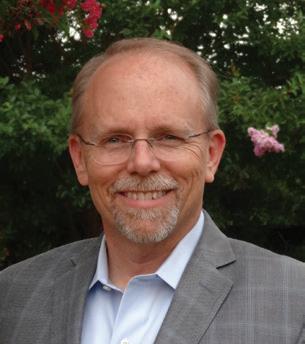

BEHIND THE IMAGINEERING STORY & UB IWERKS
Leslie Iwerks, Director & Producer
When "The Imagineering Story" premiered on Disney+ in 2019, it introduced the world to the fascinating stories, people, and technologies behind the 12 Disney Parks currently operating across three continents. Join Director and Producer Leslie Iwerks, granddaughter of Ub Iwerks and daughter of Don Iwerks, both Disney Legends. This very special presentation highlights the making of this highly acclaimed documentary series and includes a screening of one of her favorite episodes.
BANK OF AMERICA & THE WALT DISNEY COMPANY: A RELATIONSHIP DATING FROM 1930
David Mendoza, Bank of America Archivist


Hands-On Workshops:
Family Makerspace: Walt Disney’s Roo
The National Museum of Toys and Miniatures
In-person presentation and engagement activity with the National Museum of Toys and Miniatures. Learn about the different historical designs for The University of Missouri-Kansas City Roo, including the original, designed by Walt Disney himself! Partcipants will get to create their own plush version of the UMKC
HAND DRAWN ANIMATION: BRINGING ILLUSTRATIONS TO LIFE
Kansas City Art Institute
In-person presentation with Douglas Enderle (M.F.A. '81), a retired Emmy Awardwinning senior costume designer at Walt Disney Entertainment. Douglas will share his experience of a career spent in The Walt Disney Company. Enderle’s designs appear on television, on the Disney Cruise Line, and at Disney theme parks near Orlando, Fla., Anaheim, Calif., Paris, Tokyo, and Hong Kong. During his career, he received two Emmy awards nominations, and he won an Emmy for Innovative Costume Design for the 1993 ABC telecast of the “Walt Disney World Very Merry Christmas Parade.”
Join us for a virtual presentation with Bank of America Archivist, David Mendoza and learn about the relationship that began with the financing of the first animated feature-length film, "Snow White and the Seven Dwarfs" in 1930. The relationship has spanned decades and includes financing for some of Disney’s most iconic projects.

In-person, this introductory workshop is recommended for participants ages 14+. Learn the basic principles and techniques for animating life-like movement and be introduced to the foundational tools and process in bringing illustrations to life. Participants will use pencils, paper, light tablets and professional camera equipment to illustrate and then capture sequences of animation. Participants will create a collaborative, looping metamorphosis sequence, with each person being responsible for a section of animation that will seamlessly change into the next participant's section. At the end of this workshop, the class will create a combined complex, looping 20-30 second animated film.


FULL LIST OF SPEAKER SERIES and additional details available at UnionStation.org





25 UnionStation.org

A Legacy of inspiration
by Joe Rohde
Walt Disney said, “It's kind of fun to do the impossible.” Impossible is exactly what people said when we began the adventure of creating Disney’s Animal Kingdom Theme Park over 30 years ago, in early 1990. But Imagineers are an entire culture of people who regularly do the impossible. And while it can be fun, it is also many other things besides fun. It can define your life.
The challenges of building the park were offset by the privileges we enjoyed . . . The privilege of interacting with wildlife conservation leaders from around the world, the privilege of traveling to fascinating, remote locations to do the research needed to bring this park to life, the privilege of close proximity to wild animals that some people may never meet at all, and the privilege of each other's company, a talented and passionate group of people dedicated to pushing the definition of what our entire industry understood to be possible at the time.
Disney’s Animal Kingdom has been open now for long enough that there are guests who visited when they were young children, experienced the park, were inspired, and have grown up to pursue professions in wildlife conservation, in biology, in political action, and arts and design. That is the true treasure of Disney’s Animal Kingdom: it is a park about living things that is itself a living thing, perpetually changing, adapting, growing, and spinning off other lives.


The stories embodied in our parks do not remain in the parks. They are like seeds planted in the minds and hearts of our guests.
a creative consultant, artist, traveler, storyteller, and conservationist. Joe Rohde was named a Disney Legend in 2024.
26 Union Station On Track • Disney100: The Exhibition






27 UnionStation.org

Joyce “J.C.” Hall, a founder of Hall Brothers, Inc. (which would later become

Special Thanks to our Sponsors, Supporters, and Partners
Exhibition at Union Station


Red Carpet Opening Event
Honorary Chairs: The Hall Family
Red Carpet Sponsor:

Sponsored by:
In-Kind Sponsors:

Thank You To Event Sponsors:
Brancato’s Catering Haverty Family Foundation
Ewing Marion Kauffman Foundation
City Wide Facility Solutions • Peggy and Terry Dunn
Marquee Event Rentals • Parisi Coffee
Pierpont’s at Union Station • Charlie & Jeanne Sosland
VIP Supporters:
Cathy and Steve Doyal • National Museum of Toys and Miniatures
Thomas McEvoy






DISNEY
LOCAL CONNECTIONS
AND HALLMARK
time of printing 5/10/2024
At
JOHN SHERMAN
Media Partner: MARNY &








 Matt Linski President, Bank of America Kansas City
Matt Linski President, Bank of America Kansas City





 Ray Kowalik Board Chairman
Ray Kowalik Board Chairman
 George Guastello President & CEO
George Guastello President & CEO






































































































